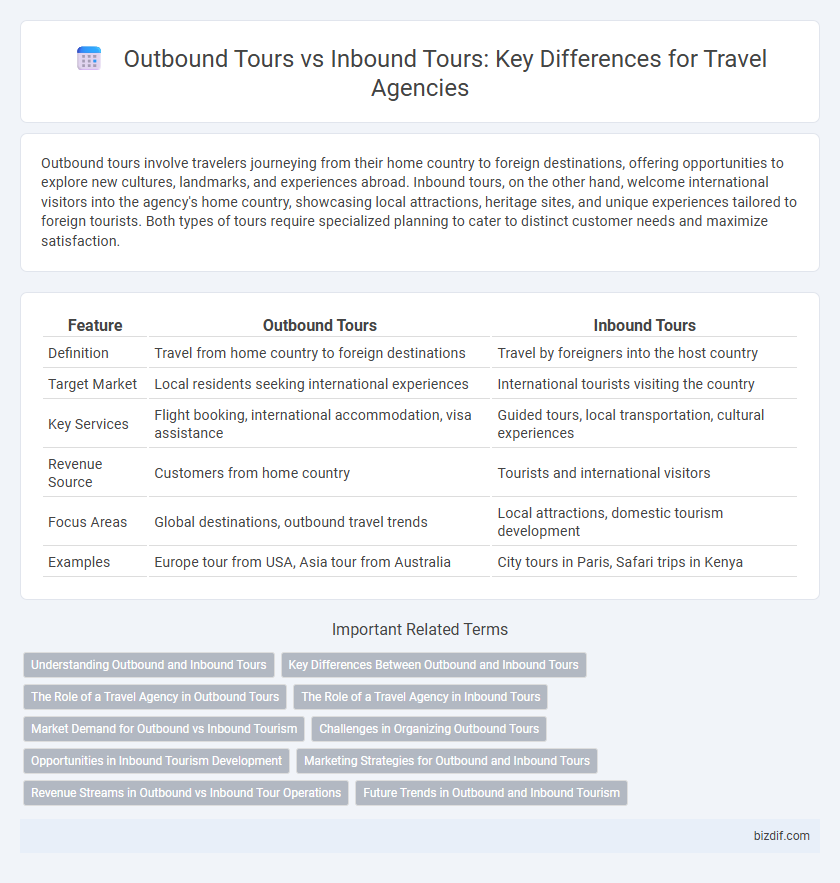Outbound tours involve travelers journeying from their home country to foreign destinations, offering opportunities to explore new cultures, landmarks, and experiences abroad. Inbound tours, on the other hand, welcome international visitors into the agency's home country, showcasing local attractions, heritage sites, and unique experiences tailored to foreign tourists. Both types of tours require specialized planning to cater to distinct customer needs and maximize satisfaction.
Table of Comparison
| Feature | Outbound Tours | Inbound Tours |
|---|---|---|
| Definition | Travel from home country to foreign destinations | Travel by foreigners into the host country |
| Target Market | Local residents seeking international experiences | International tourists visiting the country |
| Key Services | Flight booking, international accommodation, visa assistance | Guided tours, local transportation, cultural experiences |
| Revenue Source | Customers from home country | Tourists and international visitors |
| Focus Areas | Global destinations, outbound travel trends | Local attractions, domestic tourism development |
| Examples | Europe tour from USA, Asia tour from Australia | City tours in Paris, Safari trips in Kenya |
Understanding Outbound and Inbound Tours
Outbound tours involve travelers departing from their home country to explore international destinations, emphasizing curated experiences to meet diverse global interests. Inbound tours focus on attracting foreign visitors to the host country, showcasing cultural heritage, landmarks, and local attractions to boost tourism revenue. Both tour types require tailored marketing strategies and logistical planning to optimize traveler satisfaction and operational efficiency.
Key Differences Between Outbound and Inbound Tours
Outbound tours involve travelers leaving their home country to explore foreign destinations, often seeking unique cultural, recreational, or adventure experiences. Inbound tours attract international visitors to a specific country, focusing on showcasing local attractions, heritage sites, and cultural activities to boost the domestic tourism economy. Key differences lie in the target audience, marketing strategies, and regulatory requirements tailored to either sending tourists abroad or welcoming them within a nation.
The Role of a Travel Agency in Outbound Tours
Travel agencies play a crucial role in outbound tours by curating personalized travel packages, handling flight and accommodation bookings, and ensuring seamless itinerary management for international travelers. They provide expert guidance on visa requirements, local customs, and safety protocols, enhancing the overall travel experience. Travel agencies also offer 24/7 support and troubleshoot issues abroad, making outbound tours more accessible and enjoyable for clients.
The Role of a Travel Agency in Inbound Tours
A travel agency plays a crucial role in inbound tours by managing local arrangements for international visitors, including accommodations, transportation, and guided experiences that showcase regional attractions. They ensure seamless coordination between tourists and local service providers, enhancing visitor satisfaction and promoting cultural exchange. By leveraging extensive local knowledge and partnerships, travel agencies facilitate personalized and immersive travel experiences, boosting the destination's tourism economy.
Market Demand for Outbound vs Inbound Tourism
Outbound tours experience higher market demand in countries with growing middle-class populations seeking international experiences, whereas inbound tours attract significant demand in popular tourist destinations rich in cultural heritage and natural attractions. Economic factors, visa policies, and global travel trends heavily influence the fluctuation between outbound and inbound tourism markets. Data from the World Tourism Organization highlights that regions like Asia-Pacific show rapid growth in outbound travel, while Europe and North America continue to dominate inbound tourist arrivals.
Challenges in Organizing Outbound Tours
Organizing outbound tours presents challenges such as navigating complex international regulations, managing currency fluctuations, and coordinating logistics across multiple countries. Language barriers and cultural differences require specialized knowledge to ensure smooth traveler experiences. Additionally, outbound tours demand extensive risk assessment and contingency planning to address unforeseen issues like political instability or health emergencies.
Opportunities in Inbound Tourism Development
Inbound tourism development offers significant opportunities for local economies by attracting international visitors who contribute to increased revenue in hospitality, transportation, and cultural sectors. Travel agencies can capitalize on inbound tours by creating tailored packages that highlight unique destinations, authentic experiences, and local attractions, enhancing visitor satisfaction and repeat visits. Strategic partnerships with international travel operators and effective marketing campaigns targeting key source markets further boost inbound tourism growth and regional brand recognition.
Marketing Strategies for Outbound and Inbound Tours
Marketing strategies for outbound tours emphasize digital advertising targeting international travelers, leveraging social media campaigns to showcase exotic destinations and personalized travel packages. For inbound tours, marketing focuses on building partnerships with local businesses, optimizing SEO for regional attractions, and creating culturally immersive experiences that highlight authentic local heritage. Data-driven customization and multilingual content are crucial for engaging diverse traveler demographics in both outbound and inbound segments.
Revenue Streams in Outbound vs Inbound Tour Operations
Outbound tours generate revenue primarily through package sales that include international flights, accommodations, and guided experiences, attracting customers seeking global travel adventures. Inbound tours focus on local attractions and services, monetizing through partnerships with hotels, local transport, cultural experiences, and tourism operators targeting foreign visitors. Outbound tour operations typically leverage higher-margin international travel packages, while inbound tours benefit from recurring bookings and collaborations within the destination market.
Future Trends in Outbound and Inbound Tourism
Future trends in outbound tourism highlight a growing demand for personalized and immersive experiences, driven by technological advancements such as AI-driven itineraries and virtual reality previews. Inbound tourism is expected to emphasize sustainable and eco-friendly travel options, as destinations adapt to increased environmental awareness among global travelers. Both markets are set to benefit from seamless digital integration, enhancing customer convenience and engagement throughout the travel journey.
Outbound Tours vs Inbound Tours Infographic

 bizdif.com
bizdif.com